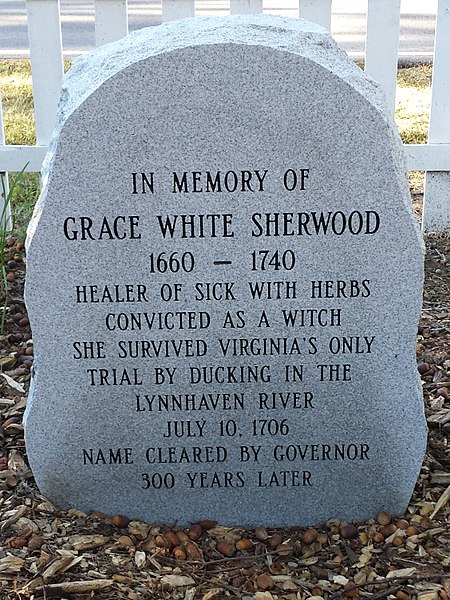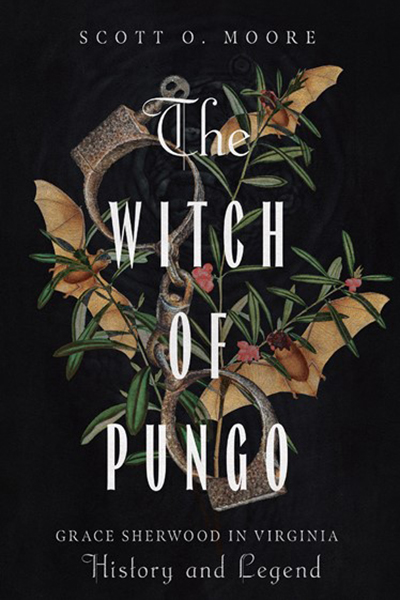- Apply
- Visit
- Request Info
- Give



Published on July 08, 2024

Scott Moore, associate professor of history at Eastern Connecticut State University and a native of Virginia Beach, VA, recently published a book about a legendary accused witch from southeastern Virginia. “The Witch of Pungo,” published through the University of Virginia Press this May, explores the legend of Grace Sherwood, who was accused of witchcraft and tried by water in 1706.
Moore’s eclectic background as a history scholar prepared him to study Sherwood from a fresh perspective. “I’m really interested in what you could think of as historical memory,” said Moore. “In other words, how do communities remember and think of their past as related to who they are?”
This holistic approach resulted in a historical account of Sherwood containing new information. “I was able to find things that really nobody had seen,” said Moore.

To find this unexplored information, Moore focused on Sherwood’s impact on the culture of southeastern Virginia rather than becoming attached to her as an individual as most scholars had done previously.
“I was... divorced from the emotional attachment to the individual,” he said. “The reason why is because, if you were to pick, the attachment is more to the history and the evolution of that cultural history.”
In Sherwood’s case, public opinion of her softened only as belief in witchcraft dwindled. “There’s this gap in history where you have (Sherwood’s trial) and then you have almost 100 years before history starts becoming professionalized,” said Moore.
“By the time you get to that retelling, American culture had decided that all people accused of witchcraft were victims of a superstitious time,” said Moore. “So, by the time the story starts getting repackaged, you start seeing this sense of, ‘she was obviously someone who was falsely accused.’”
A difficulty in finding true historical background on Sherwood is that “nobody wrote anything down,” said Moore. “Everything we’re left with is court records.
“What we do know is that she endured a trial by water, which meant that they tied her up and threw her in the water to see if she would float.”
How did colonial Virginians come to believe in witchcraft, anyway? “The English colonial communities were drawing on literally centuries of folk belief from Europe,” said Moore. “They were importing beliefs that they already had in their communities in England, which were part of the wider European belief.
“Essentially, an entire folk belief developed around how people used magic, what sort(s) of people were more likely to use magic, and that means you target people who often are seen as marginal in the community — people you might not like that much or people you might have had a conflict with.”
An example Moore often uses to illustrate the process of accusing someone of witchcraft is an accusation against Sherwood, that she was “rumored to have blighted one of her neighbors’ cotton crops and killed his pigs.

“Let’s say his cotton, all of a sudden, dies after he had a conflict with her, or one of his pigs tramples her crops and she gets in a fight with him over it. Then the next day, his pigs and crops die,” said Moore.
“That confluence of events would lead you to say, ‘well, obviously, she did it,’ especially if there were already rumors that somebody might be a witch. That’s usually how that sort of (accusation) developed.”
Despite the lack of written history surrounding Sherwood, Moore enjoyed a streamlined research and publication process. “I’ll admit that this was a very charmed project, no pun intended,” he said.
“Luckily, I have a friend who works for the University of Virginia Press as an editor,” said Moore. After reaching out to her, “there was a lot of interest immediately, so in that regard, there was a lot of support from the press, and I was really lucky because that stayed through.”
Being a native of the same region as Sherwood, Moore is “excited to see the very positive feedback and interest from the community.” Working at Eastern, Moore is in a region where other accusations of witchcraft, namely the Salem Witch Trials, are better known than Sherwood’s story, creating an interest in learning more about her.
“I’ve been pleasantly surprised that there was interest all the way up here because she’s a very clear focal point for where she is, so it’s been nice to see the interest outside her native region,” said Moore.
Written by Noel Teter